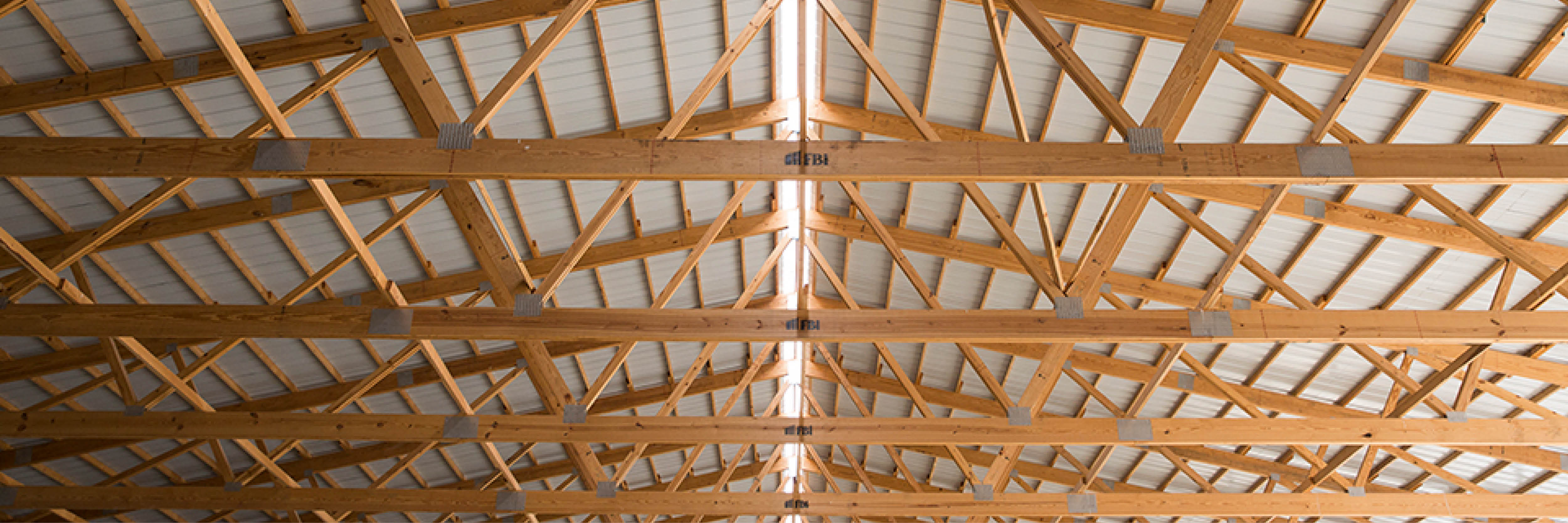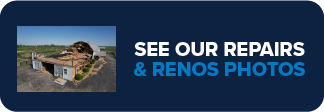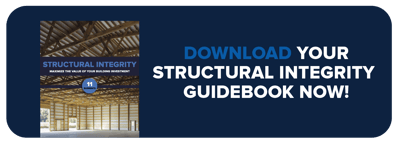Posts | Structural Integrity | Building Design
What’s the Importance of Pole Barn Wind Bracing?
Seeking a creative outlet after banking, Courtney joined FBi Buildings as Marketing Content Creator. She's passionate about writing, photography, and outdoor adventures with her dog.
Lately, it’s been incredibly windy here in the Midwest. However, this does not come as a complete surprise to all of us since it’s consistently windy year-round. With our ever-changing temperatures from day to day, it’s windier than not, and we think any Midwesterner can agree to that statement.
 Most days, the wind just comes and goes, making driving conditions a little more complicated and bringing down some small tree limbs in your yard. Other days it feels as though the wind is so strong that it might just blow your house over. When these winds blow, it’s not abnormal to feel uneasy that some structural damage could happen.
Most days, the wind just comes and goes, making driving conditions a little more complicated and bringing down some small tree limbs in your yard. Other days it feels as though the wind is so strong that it might just blow your house over. When these winds blow, it’s not abnormal to feel uneasy that some structural damage could happen.
Do you ever wonder how your pole barn is enduring the winds when they blow in? Like your house, your post frame building is in the midst of these winds and taking the brunt of their ferocity. At that moment, you’re sitting there hoping your pole barn was engineered and constructed with high winds and wind gusts in mind.
The good news is that there is a way for your pole barn to be constructed that will help increase structural integrity in the event of strong winds. There is a little something called wind bracing, which adds extra support to your post frame building’s structure. Knowing this additional support is involved should hopefully help ease your mind when you see windy days ahead in the forecast.
What is Pole Barn Wind Bracing?
Wind bracing is added security to your pole barn’s overall structure. This involves nailing 2x4’s that start at the post next to the corner post on the eave wall, then connect to the gable end frame truss near the center of the pole barn. This 2x4 is secured with a nail to the bottom of the top chord of the trusses that happen to be in its path.
In this blog, we’ll cover how wind bracing helps and advocate for why it’s important. Continue reading to learn more about wind bracing, and why your pole barn will thank you for this structural component.
How Do High Winds Affect Post Frame Buildings?
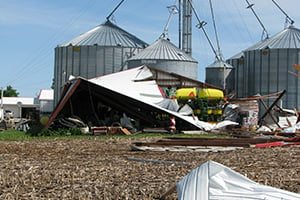
Sustained winds are quite common here in the Midwest. Most days, it feels as though the winds will never stop blowing, and it’s a wonder how everything is still standing.
You know how hard it is to walk straight when a wind gust is attempting to knock you over, so you can only imagine the wind force your post frame building is feeling when these gusts happen. If your building is in the country without much around it for protection, the chances for damage to occur is slightly higher.
That’s why we commonly stress the importance of finding a post frame builder who has their own engineering team that knows how to design buildings to preserve structural integrity.
Large buildings (like pole barns) are susceptible to tilting, overturning, and even being uplifted entirely off the foundation. What exactly do these mean?
- Shear load, also known as tilting, are horizontal forces that cause racking of the walls.
- Lateral load, also known as overturning, is horizontal pressure on the walls that could make a pole barn slide off its foundation, or even overturn.
- Uplift load, also known as uplifting, is wind flow under (or over) a roof that pushes (or pulls) upward.
Uplifting happens when wind suction is created inside your pole barn. When the suction transpires, wind pressure builds up inside, and that air is directed upwards. The higher the wind speed, the more pressure that will build. When force is strong enough, these winds can then uplift your pole barn and take it with them.
Not only can high winds bring your structure down, but they can bring large debris with them. If you live in a wooded area, these winds could bring tree branches down on your roof or send them into the side of the building, causing denting or worse.
Any loose objects around your yard, such as patio furniture, trash cans, or potted plants, can also end up being tossed into the side of your pole barn. It’s essential to keep instances like this in mind before constructing a post frame building so that hopefully, these accidental damages can be prevented.
Now, let’s take a look at how wind bracing comes into play to help prevent the damages mentioned above.
Why is Pole Barn Wind Bracing Important?
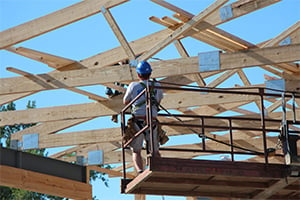 Structural integrity is the most important part of any post frame building. Structural integrity refers to a pole barn’s ability to withstand anticipated loads without breaking. Any post frame building, regardless of size and location, must be designed to resist vertical and lateral loads carefully.
Structural integrity is the most important part of any post frame building. Structural integrity refers to a pole barn’s ability to withstand anticipated loads without breaking. Any post frame building, regardless of size and location, must be designed to resist vertical and lateral loads carefully.
There are many ways to ensure your structure’s integrity is adequately secured, and one of those is wind bracing.
Pole barns are designed to withstand high wind speeds. Stick-built homes have walls that are connected to the foundation, so the potential for this type to be titled over or forced down is much greater than in post frame construction.
Unlike stick-built, post frame buildings have laminated columns that are secured deep in the ground, only adding to the concept of wind bracing. These columns are directly secured to the roof trusses, eliminating any weak links during post frame construction.
The use of high-quality materials is also vital in securing your pole barn’s structural integrity. Cheaper materials might save you money upfront, but you’ll end up paying more later on down the road when damages strike.
Materials such as the following will ensure a high standard of quality:
- Stainless steel umbrella head screws
- Machine stress rated (MSR) lumber
- Engineer-designed trusses and posts
- Galvalume steel siding and roofing
- Purlins that are screwed on, not nailed
How Is Wind Calculated for Your Area?
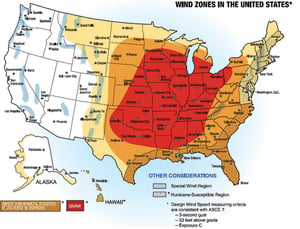 Each area of the United States has a specifically calculated wind load. Wind load refers to the internal and external wind pressure that is placed on a structure, and that is measured in pounds per square foot (psf).
Each area of the United States has a specifically calculated wind load. Wind load refers to the internal and external wind pressure that is placed on a structure, and that is measured in pounds per square foot (psf).
Certain areas of the United States are windier than others. For example, the Midwest is much windier than the lower mountains of Tennessee. For this reason, Tennessee's wind load would look much different than ours in Indiana.
The American Society of Civil Engineers Standard (ASCE 7-10) lists the codes for each area so the wind load can be calculated appropriately. The ASCE Standard takes into consideration the terrain of the area you’re planning to build your pole barn, the proximity to any large bodies of water, and the proximity to other large structures or even hills and mountains.
Other factors that help to determine your wind load are as follows:
- Basic Wind Speed
- Exposure
- Topography
- Building Height
- Building Shape
- Gaps/Leaks
Each of these components plays a critical role in your pole barn’s building design. By knowing the above, this ensures your post frame building’s structural integrity will be honored.
Are You Ready to Build Your Pole Barn?
We can’t stress enough about the importance of structural integrity and how wind bracing will significantly increase your pole barn’s structure. Living in a highly windy area, it’s crucial to ensure this component is built adequately into your post frame building.
Now that you’ve learned about the importance of wind bracing, do you feel confident enough to take the next step and build your pole barn? As a pole barn company who has over 60 years in the post frame construction industry, we want to do our best to make sure you have the proper information necessary to make an informed buying decision.
For further talking points, you can check out the official ASCE website for additional information on standards 7-10, and you can download our free Structural Integrity eBook.
As long as you remember to build with confidence, we’re positive your pole barn will be everything you envisioned it would be for many years to come.
Do you have more questions about pole barn wind bracing that are not covered in this article? If you need help designing and planning, please contact FBi Buildings at 800.552.2981 or click here to email us. If you're ready to get a price, click here to request a quote, and a member of our Customer Engagement Team will help you determine the next steps of your project.
